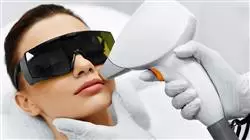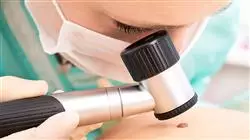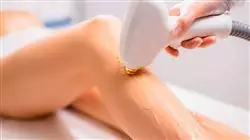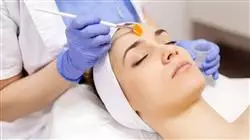
Certificate
The world's largest faculty of nursing”
Description
You will be able to offer new services to your patients thanks to this postgraduate diploma"

Of all the areas of the body that make up a person's look, the skin is the most extensive and the most exposed to wear and tear from elements such as the weather or solar radiation. For this reason, it usually requires special care and treatments to help alleviate aging and different pathologies that may affect it.
However, because it is such an important part of the body, patients often demand the best preparation from the professionals who care for them. For this reason, having up-to-date skills and knowledge can make your skin regain its lost splendor thanks to the innovative services that these nurses will be able to offer.
Therefore, this postgraduate diploma in Skin Physiology and Treatments Applied to Aesthetic Nursing is the answer for all those nursing professionals who seek to provide their patients with the best techniques in aesthetic skin treatments, so that they can experience a significant job improvement thanks to the skills acquired.
TThis excellent program will provide you with new skills and knowledge to make you a great aesthetic nursing professional"
This postgraduate diploma in Skin Physiology and Treatments Applied to Aesthetic Nursing contains the most complete and up-to-date scientific program on the market. The most important features include:
- The development of case studies presented by experts in skin physiology and aesthetic nursing
- The graphic, schematic, and practical contents with which they are created, provide scientific and practical information on the disciplines that are essential for professional practice
- Practical exercises where the self-assessment process can be carried out to improve learning
- Its special emphasis on innovative methodologies
- Theoretical lessons, questions to the expert, debate forums on controversial topics, and individual reflection assignments
- Content that is accessible from any fixed or portable device with an Internet connection
What you will learn in this degree will bring you great career opportunities"
The program includes, in its teaching staff, professionals from the sector who bring to this program the experience of their work, in addition to recognized specialists from prestigious reference societies and universities.
Its multimedia content, developed with the latest educational technology, will allow professionals to learn in professionals a situated and contextual learning, i.e., a simulated environment that will provide immersive education programmed to prepare in real situations.
The design of this program focuses on Problem-Based Learning, by means of which professionals must try to solve the different professional practice situations that are presented to them throughout the academic year. For this purpose, the student will be assisted by an innovative interactive video system created by renowned and experienced experts.
Aesthetic nursing is a growing field: specialize and get the professional improvement you were looking for"

Your patients will be satisfied thanks to the new services you will provide them"
Objectives
The main objective of this postgraduate diploma in Skin Physiology and Treatments Applied to Aesthetic Nursing is to offer its students the possibility of updating their knowledge, thanks to which they will be able to provide new services to their patients. In this way, their professional careers will experience a great boost due to their new specialization, which will make them highly sought after to apply innovative and high quality aesthetic treatments.

With this postgraduate diploma you will achieve all your professional goals"
General Objectives
- Comprehensively manage the esthetic patient, being capacity to make an accurate diagnosis and apply the most appropriate treatment
- Update and reinforce the knowledge in dermatology necessary for the correct care of esthetic nursing patients
- Provide nurses with the necessary tools and guidelines to deal efficiently with the different dermatological pathologies
- Know the general characteristics of the skin and its anatomy
- Know the basic characteristics of dermo-esthetic treatments for the Bodies
- Discern between the most effective treatments in each case
Specific Objectives
Module 1. Esthetic Nursing
- Know the basics of dermo-esthetic nursing
- Know how to structure the organization of the dermo-esthetic medicine practice
- Correctly manage the hygienic and sanitary protocols in the dermo-esthetic nursing office
- Know how to manage sanitary waste
- In-depth study of the legal aspects that should govern health care in dermo-esthetic nursing
Module 2. Skin
- Know the anatomical structures of the skin
- Explore other areas related to the skin: hair, nails, sebaceous and sweat glands, etc
- Analyze the different functions of the skin
- Know which are the different skin cares according to the patient's stage of life
- In-depth knowledge of the effects of solar radiation on the skin and the different means of photoprotection
- Learn the different types of Skin
- Understanding the basics of facial hygiene
- Know the different moisturizing techniques for the skin
Module 3. Peeling in Dermocosmetics
- Select patients in an appropriate manner, perform prior preparation of the skin, including correct follow-up and prescription of post-peel treatment, bearing in mind the usual side-effects following application of each chemical agent or combination of agents
- Understand the possible adverse effects of peeling and their treatments
- Explore types of Peels and common indications
- Examine the skin for adequate pre-preparation
- Deepen in general cosmetic skin care
- Address pathologies such as acne or aging

This degree is what you need to acquire new skills that you can use in your professional performance"
Postgraduate Diploma in Skin Physiology and Treatments Applied to Aesthetic Nursing
The skin is the largest and most exposed area of the human body, so it needs special care and treatments to prevent aging and diseases that can affect it. Patients demand the best preparation in skin care from healthcare professionals, which requires up-to-date skills and knowledge to offer cutting-edge services and help people regain their physical qualities. To address these needs, the Postgraduate Diploma in Skin Physiology and Treatments Applied to Aesthetic Nursing has been designed, which will guarantee your nursing update in just 6 months.
Get your desired professional update from home
Through the Postgraduate Diploma in Skin Physiology and Treatments Applied to Aesthetic Nursing, you will acquire the cutting-edge procedures to optimize dermatological care at any age stage or improve the care of patients undergoing a dermocosmetic peeling. All this, following a 100% online methodology that will allow you to study without the need to give up your personal and professional duties. Do not hesitate any longer and enroll in this program to preserve your professional update!






